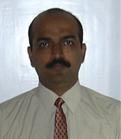The concept of Prakriti and Brahmanda is
very beautiful. Prakriti is nature. It is the world as it is. Thus, it's
definition is the same for everyone. Every human being has the power of
imagination and believes the self to be special. Thus, one creates his own
definition of the world. This perception gives rise to Brahmanda which is
unique to each individual. Prakriti, therefore, resembles the objective reality
whereas Brahmanda represents the subjective reality.
Shiva is the greatest tapasvin. He has
liberated himself from the rules of Prakriti and does not try to control it.
His control on his mind and his inward looking concentration also ensures he
does not create his own Brahmanda. Thus, he does not own anything and detaches
himself from all things - material or spiritual. Just as a surface looks white
when it reflects back all colours in the spectrum, so does Shiva reflects back
all things material. He is equally indifferent to objective and subjective
reality.
The two shut eyes of Shiva embodies that
nothing is rejected or selected by him. Nothing is approved or disapproved,
nothing is included or excluded. Everything is the same. The third eye of Shiva
embodies the absence of discrimination and choice. In doing so, Shiva remains
aloof from the human world. His wisdom remains divorced from the world.
This wisdom, thus, does not benefit humans.
The mythology is full of events that aim at getting Shiva to be involved in
this world of humans. His consort, Gauri or Parvati, both aim to get him
involved with the world.
His son, Ganesha, is more involved with the
human world. Here I borrow from Devdutt Pattanaik's book "7 Secrets of
Shiva". The pictures or statues of Ganesha often show two symbols of an
axe and a noose. The axe represents analytical skills that enable one to
separate objective from subjective reality whereas the noose represents the
ability to outgrow this distinction and to unite the opposites.
There is an excellent analogy to the world
of analytics in this mythological setup. The world of business is the world of
data. This data is absolute and uniform across. The data forms the Prakriti of
business. However, business leaders tend to form their own ideas and
conclusions basis their beliefs. This is
the individual Brahmanda. Ignoring both the objective data and the subjective
beliefs would make one aloof from the business. This is not a desirable state
of affairs for the business stakeholders.
One needs the ability to separate the
objective, analytical driven decisions with the subjective, gut feel based
decision. However, it is not a choice of one over the other. It is required to
have the noose in place that considers both option and uses one to reinforce
the other with equal respect. Malcolm Gladwell advocates the importance of
experience or gut feel. But he also goes on to qualify the subjective decision
as those that arise out of 10,000 hours of repetitive experience. Tom Davenport
occupies the opposite spectrum of analytical decision making. But neither
approach tends to eliminate the other. Each needs to respect the other approach
even if it means they are contradicting to each other.
The business that learns to gel the two
approaches together as a process will benefit from analytics. But often,
business leaders tend to look at analytics as a challenge to their business
acumen, especially when the models throw up insights that contradict their
belief. They would benefit if they look at analytics to validate their
assumption and accept the results. Similarly, the analytical outfit tend to
override business approaches without considering the situation on the ground.
Data may showcase a certain behaviour but the true nature of the causal or
correlated behaviour can only be known by considering the experience of the
business leader on the field.
Ancient India has already given this lesson
to us. They understood the difference and the combined importance of both the
subjective and analytical approach. Modern business should learn from ancient
knowledge to benefit from both approaches.
The blessings from Mount Kailash is
available for those who are ready to consume and benefit from it.
